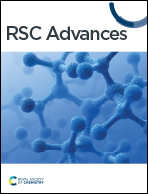AuPt nanoalloy with dual functionalities for sensitive detection of HPV16 DNA†
Abstract
Human papillomavirus type 16 (HPV16), one of the high-risk types, is responsible for 53% of cervical cancers. The development of an early diagnostic approach with high sensitivity, low-cost, point-of-care testing (POCT) for HPV16 is urgent. In our work, a novel dual-functional AuPt nanoalloy-based lateral flow nucleic acid biosensor (AuPt nanoalloy-based LFNAB) was established with excellent sensitivity for detecting HPV16 DNA for the first time. The AuPt nanoalloy particles were prepared by a one-step reduction method, which was simple, rapid, and green. The AuPt nanoalloy particles retained the performance of initial Au nanoparticles owing to the catalytic activity enabled by Pt. Such dual-functionalities offered two kinds of detection alternatives (i.e., normal mode and amplification mode, respectively). The former is produced just by the black color from the AuPt nanoalloy material itself, and the latter is more color sensitive from its superior catalytic activity. The optimized AuPt nanoalloy-based LFNAB exhibited satisfactory quantitative ability in detecting the target HPV16 DNA in the range of 5–200 pM with a LOD of 0.8 pM at the “amplification mode”. The proposed dual-functional AuPt nanoalloy-based LFNAB displayed great potential and promising opportunity in POCT clinical diagnostics.



 Please wait while we load your content...
Please wait while we load your content...